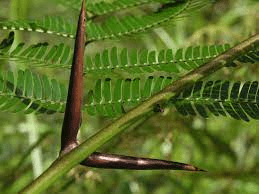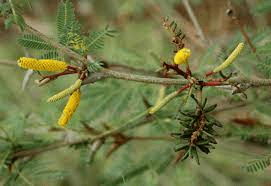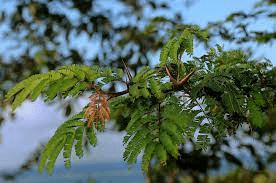Vachellia cornigera, commonly known as Bullhorn Acacia, is a distinctive and intriguing species of tree native to Central America and parts of Mexico.
Belonging to the Fabaceae family, this small to medium-sized tree is renowned for its fascinating symbiotic relationship with certain ant species, particularly the Pseudomyrmex ferruginea.
The Bullhorn Acacia typically reaches heights of 6 to 15 meters, featuring a rounded crown and dark green, bipinnate leaves composed of numerous small leaflets.
What sets this acacia apart is its remarkable, hollow thorns resembling bull’s horns that grow at the base of its leaves. These enlarged thorns serve both as a deterrent against herbivores and as specialized nesting sites for the protective ants.
The mutualistic association between Vachellia cornigera and the resident ants is a remarkable ecological adaptation. In return for shelter and nourishment provided by the acacia, the ants fiercely defend the tree against potential threats.
They actively discourage herbivores, clearing the tree of encroaching vegetation, and even attack larger animals that attempt to browse on the acacia’s foliage.
Apart from its ecological significance, Bullhorn Acacia holds cultural importance in traditional medicine. Various parts of the tree, including the bark and leaves, are utilized by indigenous communities for their potential medicinal properties. The tree’s gum, in particular, has been historically employed for its adhesive qualities.
In a broader ecological context, Vachellia cornigera plays a crucial role in its ecosystem by providing habitat and sustenance for a myriad of organisms.
Its distinctive appearance, coupled with the captivating interdependence with protective ants, renders Bullhorn Acacia not only an ecologically vital species but also a captivating subject for scientific study and admiration in the diverse landscapes it inhabits.
The Botanical Description of Vachellia cornigera
1. Leaf Arrangement: Vachellia cornigera, commonly known as Bullhorn Acacia, exhibits alternate leaf arrangement along its branches. The leaves are pinnately compound, with multiple leaflets attached to a central stalk.
2. Leaflet Characteristics: Each leaflet is lanceolate in shape, featuring a pointed tip and a smooth margin. The leaflets are arranged in a manner that resembles the shape of a bull’s horn, contributing to the plant’s common name.
3. Thorny Appearance: One prominent feature of Vachellia cornigera is its thorny appearance. The plant is armed with large, hollow thorns that house stinging ants. This unique adaptation forms a mutualistic relationship between the plant and the ants, offering protection to the acacia in exchange for shelter and food for the ants.
4. Bark Texture: The bark of Vachellia cornigera is typically grayish-brown, with a rough and fissured texture. The bark serves as a protective layer for the tree, safeguarding it against environmental factors.
5. Flower Structure: The plant produces small, pale yellow flowers in clusters. The inflorescences are typically spherical and add aesthetic appeal to the tree when in bloom. The flowers play a crucial role in the reproductive cycle of Vachellia cornigera.
6. Fruit Characteristics: Vachellia cornigera bears elongated, pod-like fruits. These pods contain seeds and play a vital role in the dispersal of seeds, contributing to the plant’s reproductive success.
7. Canopy Form: The canopy of Vachellia cornigera forms an umbrella-like structure, providing shade in its native habitats. The arrangement of leaves and branches creates a visually distinct silhouette.
8. Growth Habit: This acacia species often exhibits a shrub-like growth habit, and its size can vary based on environmental conditions. In some instances, it may grow into a small tree with a height ranging from 3 to 10 meters.
9. Root System: Vachellia cornigera typically develops a fibrous root system that aids in nutrient absorption and provides stability to the plant. The root system adapts to various soil conditions, allowing the plant to thrive in different environments.
10. Adaptive Features: Beyond its thorny appearance, Vachellia cornigera showcases adaptive features such as modified stipules that act as nectaries to attract ants. This unique symbiotic relationship between the acacia and the ants is a fascinating aspect of its botanical makeup.
The Geographic Distribution of Vachellia cornigera

1. Native Regions: Vachellia cornigera is native to regions of Central America, including Mexico, Honduras, Guatemala, and Nicaragua. It thrives in diverse ecosystems, ranging from tropical forests to arid landscapes.
2. Altitudinal Range: The geographic distribution of Vachellia cornigera spans different altitudinal ranges. It can be found at elevations ranging from sea level up to 1,500 meters above sea level, showcasing its adaptability to varying environmental conditions.
3. Preferred Climate: This acacia species favors tropical and subtropical climates. It is often encountered in areas characterized by warm temperatures, high humidity, and distinct wet and dry seasons.
4. Soil Preferences: Vachellia cornigera demonstrates versatility in its soil preferences. It can thrive in well-drained soils, including sandy and loamy substrates. The plant’s ability to adapt to different soil types contributes to its wide distribution.
5. Habitat Types: Bullhorn Acacia is commonly found in a variety of habitats, including rainforests, deciduous forests, and savannas. Its adaptability allows it to establish itself in different ecological niches.
6. Ecological Interactions: The geographic distribution of Vachellia cornigera is closely linked to its ecological interactions. The plant forms mutualistic relationships with stinging ants, which inhabit the hollow thorns and provide protection against herbivores.
7. Human Cultivation: In addition to its natural distribution, Vachellia cornigera is also cultivated in botanical gardens and arboreta worldwide due to its intriguing botanical features and ecological significance.
8. Invasive Potential: While not inherently invasive, Vachellia cornigera may establish itself in new environments where suitable conditions are present. Care should be taken to prevent unintended impacts on local ecosystems if introduced outside its native range.
9. Conservation Status: Assessing the geographic distribution of Vachellia cornigera is essential for conservation efforts. While not currently listed as endangered, monitoring its populations and addressing potential threats is crucial for its long-term survival.
10. Global Presence: Beyond its native range, Vachellia cornigera has gained recognition globally for its unique ecological adaptations. Its presence in botanical collections and research facilities contributes to a broader understanding of plant-animal interactions.
The Chemical Composition Of Vachellia cornigera
1. Alkaloids: Vachellia cornigera contains alkaloids, chemical compounds with potential pharmacological properties. Alkaloids play a role in the plant’s interactions with herbivores and may contribute to its defensive mechanisms.
2. Flavonoids: Flavonoids are present in the leaves and flowers of Vachellia cornigera. These compounds contribute to the plant’s antioxidant properties and may play a role in various physiological processes.
3. Tannins: The bark of Vachellia cornigera contains tannins, which contribute to its astringent properties. Tannins may also have antimicrobial effects and play a role in the plant’s interactions with its environment.
4. Essential Oils: Some components of Vachellia cornigera, particularly in its flowers, may contain essential oils. These oils can have aromatic and potentially therapeutic properties.
5. Proteins and Amino Acids: The seeds of Vachellia cornigera contain proteins and amino acids. These nutritional components contribute to the plant’s role in the diet of certain animals and insects.
6. Lipids: Lipids, including fatty acids, are found in various parts of Vachellia cornigera. These compounds play essential roles in cellular structure and may have physiological significance in the plant.
7. Saponins: Saponins, natural detergents with foaming properties, are present in Vachellia cornigera. These compounds may have ecological roles, and their presence contributes to the chemical diversity of the plant.
8. Phenolic Compounds: Vachellia cornigera contains phenolic compounds, including phenolic acids. These compounds contribute to the plant’s antioxidant properties and may have implications for human health.
9. Carbohydrates: Carbohydrates, including sugars and polysaccharides, are essential components of Vachellia cornigera. These compounds serve as energy sources and structural elements in various plant tissues.
10. Secondary Metabolites: Beyond the listed components, Vachellia cornigera produces a range of secondary metabolites. These compounds contribute to the plant’s overall chemical complexity and ecological interactions.
Read Also: 15 Medicinal Health Benefits Of Wahoo (Euonymus atropurpureus)
The Medicinal Health Benefits Of Vachellia cornigera (Bullhorn Acacia)

1. Anti-Inflammatory Properties: Vachellia cornigera exhibits potent anti-inflammatory properties, providing relief from inflammatory conditions and promoting overall well-being.
2. Analgesic Effects: The plant offers analgesic effects, making it a valuable natural remedy for various types of pain, from mild discomfort to chronic conditions.
3. Antimicrobial Action: Vachellia cornigera possesses antimicrobial properties, combating bacterial and fungal infections in traditional and natural medicine.
4. Wound Healing Acceleration: Traditional use involves applying Vachellia cornigera extracts to wounds, accelerating the healing process for cuts, abrasions, and injuries.
5. Antioxidant Support: Rich in antioxidants, the plant neutralizes free radicals, contributing to overall health and potentially reducing the risk of chronic diseases.
6. Respiratory Health Improvement: Vachellia cornigera may aid in alleviating respiratory issues like coughs and congestion, promoting clear breathing.
7. Gastrointestinal Relief: Traditional usage highlights its positive effects on gastrointestinal health, providing relief from digestive issues.
8. Immune System Support: Regular use may contribute to immune system support, enhancing the body’s natural defenses against infections.
9. Stress Reduction and Relaxation: Some traditional uses suggest calming effects, contributing to stress reduction and relaxation for physical and mental well-being.
10. Anti-allergic Potential: Preliminary research indicates potential anti-allergic effects, making it valuable for managing allergic reactions and hypersensitivity.
The Methods of Usage to Achieve the Provided Health Benefits Of Vachellia cornigera (Bullhorn Acacia)
1. Topical Applications: Apply Vachellia cornigera extracts or formulations topically for wound healing and skin-related benefits.
2. Infusions and Decoctions: Prepare infusions or decoctions from leaves or bark for internal use, consuming as teas or tonics.
3. Dietary Supplement Form: Incorporate Vachellia cornigera in dietary supplement form, such as capsules or tinctures, for daily health benefits.
4. Inhalation for Respiratory Benefits: Inhale steam infused with extracts or use essential oils for respiratory health, relieving congestion.
5. Poultices for Analgesic Effects: Create poultices for external application on areas experiencing pain, providing localized analgesic effects.
6. Culinary Uses: In regions where it’s part of the culinary landscape, incorporate Vachellia cornigera into dishes for flavor and health benefits.
7. Herbal Combinations: Combine Vachellia cornigera with other herbs for enhanced efficacy in formulations or herbal blends.
8. Aromatherapy: Utilize Vachellia cornigera essential oils in aromatherapy practices for stress reduction and relaxation.
9. Traditional Rituals and Ceremonies: Incorporate Vachellia cornigera into traditional rituals or ceremonies in cultural contexts.
10. Controlled Dosage in Medicinal Products: Use commercially available medicinal products for precise and controlled dosage, ensuring a standardized approach.
The Side Effects Of Using Vachellia cornigera Medicinal Plant
1. Skin Irritation: Topical applications may lead to skin irritation in some individuals. Perform a patch test before extensive use.
2. Gastrointestinal Distress: Excessive consumption of infusions may result in gastrointestinal distress. Adhere to recommended dosage guidelines.
3. Allergic Reactions: Exercise caution if allergic; rare reactions may occur, necessitating discontinuation and medical consultation.
4. Respiratory Sensitivity: Inhalation methods should be approached with caution, especially by individuals with respiratory sensitivities.
5. Interactions with Medications: Vachellia cornigera may interact with certain medications; consult healthcare professionals if regularly taking prescribed drugs.
6. Photosensitivity: Topical application may cause photosensitivity. Avoid prolonged sun exposure during and after use.
7. Digestive Upset in Sensitive Individuals: Individuals with sensitive digestive systems may experience mild upset. Adjust dosage or opt for alternative methods.
8. Pregnancy and Breastfeeding Precautions: Pregnant or breastfeeding individuals should consult healthcare professionals before use.
9. Avoiding Overharvesting: Harvesters should practice responsible harvesting to prevent negative impacts on natural populations.
10. Quality Control and Adulteration: Users should be cautious about the quality and authenticity of commercially available Vachellia cornigera products.
Read Also: 16 Medicinal Health Benefits Of Hoodia (Hoodia gordonii)
The Scientific Research and Studies of Vachellia cornigera

1. Ecological Interactions and Ant-Plant Mutualism: Numerous scientific studies have investigated the unique mutualistic relationship between Vachellia cornigera and stinging ants. This relationship enhances protection against herbivores and influences the plant’s reproductive success.
2. Chemical Ecology and Defensive Strategies: Research has focused on the chemical ecology of Vachellia cornigera, revealing secondary metabolites like alkaloids, flavonoids, and tannins that contribute to its defensive strategies against herbivores.
3. Seed Dispersal Dynamics: Studies have explored the seed dispersal dynamics of Vachellia cornigera, examining factors influencing seed dispersal distances and their implications for the plant’s reproductive success.
4. Conservation Genetics: Genetic diversity and population dynamics of Vachellia cornigera have been subjects of study in conservation genetics, assessing the health of populations and formulating conservation strategies.
5. Antimicrobial Properties and Medicinal Potential: Scientific research has delved into the antimicrobial properties of Vachellia cornigera, exploring compounds like tannins and alkaloids for potential medicinal applications.
6. Ecological Impact of Human Interventions: Studies have assessed how human interventions, such as deforestation, impact the ecology of Vachellia cornigera, providing insights for conservation efforts.
7. Phylogenetic Relationships: Phylogenetic studies have elucidated the evolutionary relationships of Vachellia cornigera within the Acacia genus, offering insights into its evolutionary history and ecological roles.
8. Allelopathic Effects on Surrounding Vegetation: Scientific research has explored the allelopathic effects of Vachellia cornigera on neighboring vegetation, studying chemical compounds that may influence the growth of nearby plant species.
The Safety Precautions and Recommendations In Using Vachellia cornigera Medicinal Plant
1. Allergic Reactions and Skin Sensitivity: Exercise caution to prevent allergic reactions or skin sensitivity when using Vachellia cornigera. Conduct a patch test before extensive use for topical applications.
2. Consultation with Healthcare Professionals: Prior to using Vachellia cornigera products, consult healthcare professionals, especially for individuals with pre-existing conditions, pregnant or breastfeeding women, and those taking medications.
3. Dosage Guidelines: Adhere to recommended dosage guidelines when using Vachellia cornigera products to prevent adverse effects. Follow instructions provided by reputable sources or healthcare practitioners.
4. Identification and Authentication: Ensure the accurate identification and authentication of Vachellia cornigera products. Source materials from reliable suppliers to guarantee authenticity and quality.
5. Potential Interactions with Medications: Be aware of potential interactions between Vachellia cornigera and certain drugs. Consult healthcare professionals, especially for individuals taking medications regularly.
6. Adherence to Traditional Practices: If using Vachellia cornigera based on traditional practices, adhere to established guidelines within the specific cultural context to maintain the cultural integrity of its use.
7. Sustainable Harvesting Practices: For harvesters, adopt sustainable practices to prevent overharvesting. Responsible harvesting ensures the long-term availability of Vachellia cornigera.
8. Awareness of Potential Side Effects: Be aware of potential side effects associated with the use of Vachellia cornigera, including gastrointestinal distress or skin irritation. Monitor for adverse reactions and discontinue use if necessary.
9. Storage Conditions: Properly store Vachellia cornigera products to maintain efficacy and safety. Follow recommended storage conditions, avoiding exposure to excessive heat or moisture.
10. Quality Control and Product Authenticity: Prioritize products that undergo rigorous quality control measures. Ensure the authenticity of Vachellia cornigera-derived products to guard against adulteration and guarantee the presence of beneficial compounds.
FAQs About Vachellia cornigera Medicinal Plant
1. Is Vachellia cornigera Safe for Topical Use?
Yes, it can be used topically, but a patch test is recommended to assess individual skin sensitivity. Discontinue use if irritation occurs.
2. Can Pregnant or Breastfeeding Individuals Use Vachellia cornigera Products?
Consult healthcare professionals before use to ensure safety for both the mother and the baby.
3. What Precautions Should Be Taken for Internal Use?
Adhere to recommended dosage guidelines and consult healthcare professionals, especially for individuals with existing medical conditions or those taking medications.
4. How Can Users Identify Authentic Vachellia cornigera Products?
Source products from reputable suppliers, verify product quality, and seek certification from regulatory bodies for authenticity.
5. Are There Known Drug Interactions with Vachellia cornigera?
Consult healthcare professionals to identify potential interactions and prevent adverse effects, especially for individuals taking drugs regularly.
6. What Safety Measures Should Harvesters Follow?
Adopt sustainable practices, respect traditional knowledge, and follow ethical harvesting guidelines to prevent overharvesting.
7. Can Vachellia cornigera Be Used in Traditional Medicine?
Yes, adhere to traditional practices, cultural guidelines, and consult knowledgeable practitioners for its traditional medicinal use.
8. What Should Users Do in Case of Allergic Reactions?
Discontinue use and seek medical advice if allergic reactions, such as skin irritation, occur. Perform a patch test before use to identify potential sensitivities.
9. Is Vachellia cornigera Endangered?
As of current knowledge, it is not listed as endangered. Monitor populations and address potential threats for long-term conservation.
10. Can Vachellia cornigera Be Incorporated into Daily Health Routines?
Yes, users can incorporate it into daily health routines following recommended guidelines for topical applications, dietary supplements, or traditional practices aligned with personal wellness goals.**
Read Also: Gazania Care 101: How to Keep Your Garden Blooming





